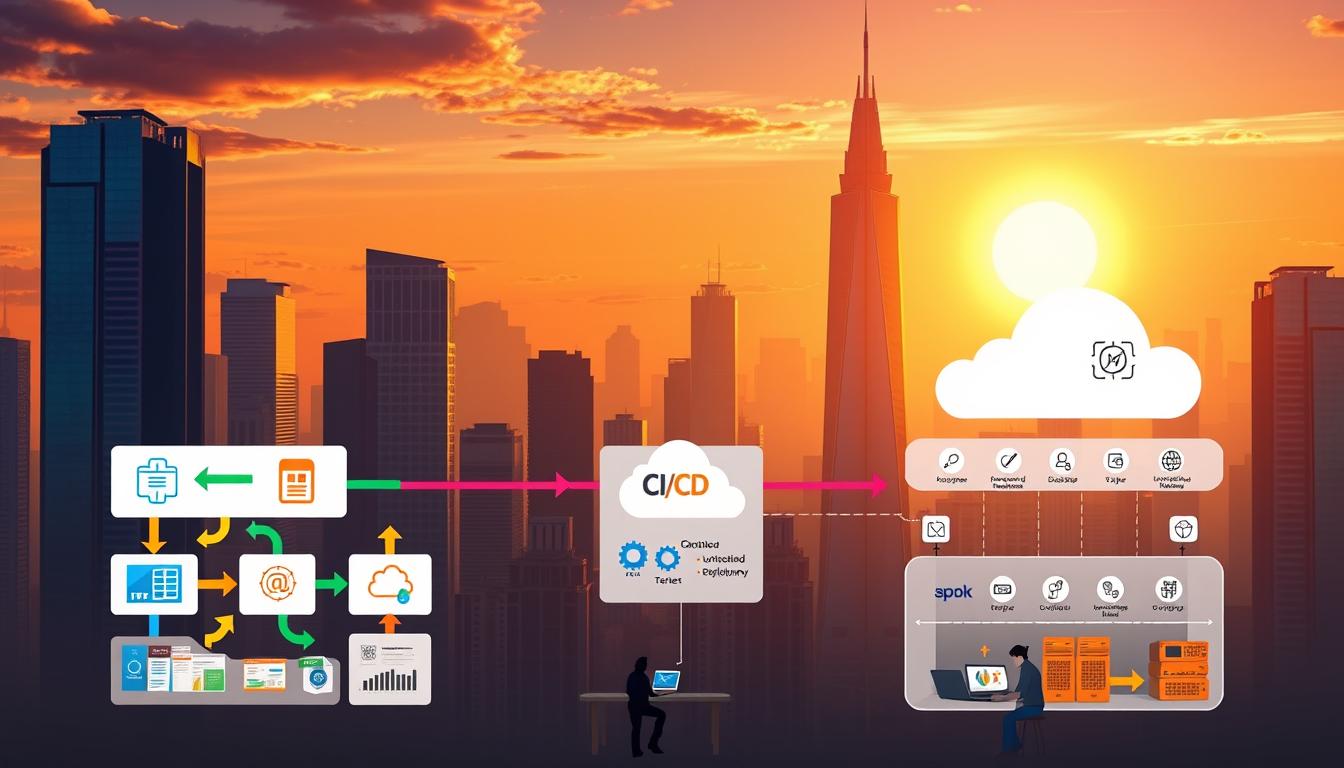Embarking on the journey to integrate continuous integration and delivery on cloud servers signifies a pivotal moment in the evolution of your software development paradigm. This initiative is paramount for expediting deployment cycles, enhancing software quality, and curtailing operational expenses. The establishment of a CI/CD pipeline serves as a linchpin, automating the testing, compilation, and deployment phases, thereby simplifying the maintenance and oversight of your software endeavors.
The advent of cloud-based delivery models has redefined the landscape of software development, positioning continuous integration and delivery as indispensable competencies. A meticulously crafted CI/CD pipeline guarantees that your software remains current, fortified against vulnerabilities, and compliant with regulatory benchmarks. This discourse aims to elucidate the advantages and methodologies for integrating continuous integration and delivery on cloud servers, thereby facilitating the optimization of your software development workflow.
Understanding Continuous Integration and Delivery (CI/CD)
In the realm of software development, the concepts of continuous integration and continuous delivery emerge as pivotal. These methodologies are indispensable for maintaining the integrity and dependability of software applications. Within a cloud environment, CI/CD assumes a critical role, facilitating the optimization of the development lifecycle. This enables the expedited deployment of enhancements and functionalities, thereby enhancing operational efficiency.
The implementation of CI/CD offers manifold advantages. Notably, it fosters collaborative environments, automates testing protocols, and drastically shortens the interval between feature releases and updates. Through the adoption of CI/CD, the quality of software applications is elevated, error rates are diminished, and customer satisfaction is amplified.
Several prominent tools and platforms, such as Jenkins, GitLab CI/CD, and CircleCI, are instrumental in the CI/CD process. These tools provide functionalities like automated build, test, and deployment, thereby simplifying the management and refinement of CI/CD pipelines. Selecting the most appropriate tools and platforms is essential for maximizing the CI/CD benefits and elevating software development standards.
Grasping the significance of continuous integration and continuous delivery empowers you to make strategic decisions regarding CI/CD integration into your software development workflow. With the deployment of the correct tools and methodologies, the full spectrum of CI/CD can be harnessed. This leads to accelerated, more reliable, and more efficient software development within a cloud environment.
Preparing Your Cloud Environment for CI/CD
The initiation of Continuous Integration and Delivery (CI/CD) on cloud servers necessitates a meticulous preparation of the cloud environment. It is imperative to ensure that the cloud environment is optimized to fulfill the requirements of CI/CD, encompassing scalability, reliability, and security. The selection of a cloud provider is a foundational step, requiring consideration of cost, services offered, and scalability.
Within the cloud environment, the establishment of requisite cloud infrastructure is paramount, including virtual machines, storage, and networking. This infrastructure serves as the cornerstone for CI/CD pipelines, facilitating the automation of build, test, and deployment processes for applications. Cloud providers such as AWS, Azure, and Google Cloud offer a plethora of services to support CI/CD, including containerization, orchestration, and automation tools.

To safeguard the security and integrity of the cloud environment, the configuration of security measures is essential. This includes access controls, encryption, and monitoring, aimed at protecting data and applications from unauthorized access and ensuring regulatory compliance. By dedicating time to the preparation of the cloud environment, one can confidently implement CI/CD, assured of a secure, scalable, and reliable cloud infrastructure.
Several critical factors must be considered when preparing the cloud environment for CI/CD:
- Scalability: Does the cloud provider possess the capability to scale in response to the demands of CI/CD pipelines?
- Security: What measures are in place to safeguard data and applications from unauthorized access?
- Cost: What are the financial implications of utilizing the cloud provider, and how will it affect the CI/CD budget?
Implementing CI/CD Pipelines on Cloud Servers
Embarking on the journey to implement CI/CD pipelines on cloud servers necessitates a deep dive into the practicalities of workflow design and automation. This entails a meticulous examination of build processes, testing, and deployment to guarantee the efficient delivery of software. The integration of version control systems, such as Git, plays a pivotal role in managing code changes and fostering collaboration.
In the realm of workflow design, several critical elements must be considered:
- Build processes: Automate build processes to ensure consistency and efficiency.
- Testing: Implement automated testing to identify and fix issues early in the development cycle.
- Deployment: Automate deployment processes to ensure smooth and efficient delivery of software updates.
The utilization of automation tools, such as Docker and Kubernetes, is instrumental in streamlining your CI/CD pipelines. This approach facilitates continuous testing and deployment, thereby enabling the rapid and efficient delivery of high-quality software. Moreover, it significantly reduces the risk of errors and downtime.
Monitoring and Managing CI/CD Processes
Post-establishment of CI/CD pipelines, the imperative shifts towards monitoring and managing these processes to enhance and rectify them. This necessitates the tracking of pivotal performance indicators (KPIs) such as build success rates, deployment frequencies, and lead times. Through the monitoring of these KPIs, one can pinpoint areas for enhancement and execute decisions backed by data.
Utilizing continuous monitoring tools like Prometheus and Grafana facilitates the tracking of these metrics, offering real-time insights into CI/CD processes. These tools empower the identification of issues prior to their escalation, thereby mitigating the risks associated with CI/CD challenges such as pipeline failures and security breaches.

To mitigate prevalent CI/CD challenges, several strategies are advisable:
- Adopt automated testing and deployment methodologies to diminish manual error rates
- Employ continuous monitoring tools to monitor KPIs and pinpoint areas for enhancement
- Establish unequivocal communication channels among team members to foster collaboration and expedite issue resolution
By integrating these strategies and leveraging continuous monitoring tools, one can ensure the seamless operation of CI/CD processes. This, in turn, enhances the quality and dependability of software releases. The efficacy of Monitoring CI/CD processes is paramount for optimizing CI/CD pipelines and realizing software development objectives.
Best Practices for Continuous Integration and Delivery
In the pursuit of optimizing your cloud infrastructure, the adoption of CI/CD best practices emerges as a pivotal strategy. The maintenance of consistency across various deployment stages is paramount. It is imperative to ensure that your development, staging, and production environments exhibit a high degree of similarity. This approach minimizes the risk of unforeseen complications during the deployment phase.
The importance of comprehensive documentation and effective communication cannot be overstated in the context of CI/CD pipeline success. It is crucial to document your processes, configurations, and any troubleshooting methodologies meticulously. This documentation should be accessible to your team at all times. Through regular collaboration and information exchange, your team can maintain alignment and proactively address any challenges that may arise.
Ultimately, the integration of automation into your CI/CD workflows is key to continuous improvement. Automating tasks such as testing, packaging, and deployment can significantly streamline the software delivery process. This not only enhances efficiency but also diminishes the occurrence of manual errors, thereby ensuring more reliable and consistent deployments.
By adhering to these best practices, you can establish a resilient and flexible CI/CD system. Such a system empowers your organization to deliver high-quality software updates with both speed and confidence.
